Today’s flag choice is Uganda.

For those who don’t know, Uganda is a small nation in Eastern Africa, with Kenya to the east, South Sudan to the north, Democratic Republic of the Congo to the west, and Rwanda and Tanzania to the south. Uganda has a very large shoreline on Lake Victoria, and the entire frontier with Tanzania is located through the lake’s waters.
The Ugandan capital city is Kampala, located in the south-central part of the country, however, the international airport location, which is the air link with the world, is located further south in the city of Entebbe. Entebbe is currently gaining a good deal of attention due to the movie “Seven Days in Entebbe” which highlights one of the less glowing moments in the history of Uganda.
Uganda was colonized by the British moving in from their colony in Kenya. The country was primarily a source of cotton for British mills, although in later years tea, coffee, and sugar would start to command a larger portion of the economy. As was typical of a colonial economy, Uganda produced raw materials for the mother country and manufactured goods were shipped back. This pattern would result in little to zero industrial development in what would soon be an independent nation.
Uganda had a large population of east Indian indentured workers who arrived in the late 19th century to work on the Uganda Railway, a project to link the interior areas of Kenya and Uganda, which is otherwise without access to the sea, to the Kenyan seaport of Mombassa. While most of the east Indians returned home at the end of their contracts, some 6,000+ decided to stay.
The east Indians quickly came to dominate the merchant class, a pattern common throughout former British colonies in eastern and southern Africa. The dominance of this class of worker, who often was more affluent than the customers who relied on their stores, bred intense resentment against the east Indians who were viewed as interlopers, even if they had been in country for generations.
The resentment against the east Indian population, along with tribal conflicts known as the Buganda crisis, all converged to lead to the dictatorship of General Idi Amin. Of course, this is a GROSSLY simplistic version of events and those with an interest in the detailed events should look elsewhere.
Idi Amin proved to be an infamous and depraved ruler who murdered somewhere between 80,000 and 500,000 Ugandans. Amin also forced all people of east Indian heritage, regardless of who long they had lived in Uganda, to depart with almost zero notice and limited, if any, ability to take material goods or money with them.
Amin was overthrown with the help of neighboring Tanzania, after Amin foolishly declared war against the country. The years between the overthrow of Amin, 1979, to 1986 were marked by relative chaos.
In 1986 Yoweri Kaguta Museveni, who was also instrumental in overthrowing Amin, deposed the government of Milton Obote, who had been in power from 1979. Museveni, despite being celebrated as a new generation of African leaders, has remained in power from 1986 to the present day.
